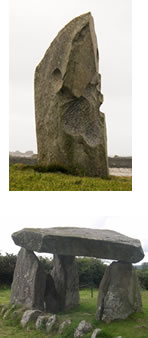
The word menhir come up in discussion yesterday and I posted it on Facebook today along with the the Welsh translation maen hir, which is what I found in this dictionary. This provoked further discussion about whether the two terms mean the same thing. So I thought I’d find out.
A menhir is a standing stone of the kind that Obelix delivers in the Asterix books. According to the Dictionary of Word Origins and the OED, menhir comes from Breton mean-hir (long stone), which is what the Welsh term maen hir means, so it seems that they are the same. The usual Breton word for such standing stones is peulvan, however.
The word dolmen (a prehistoric structure of two or more upright stones surmounted by a horizontal one), comes via French from Breton: the men part means stone, and the dol part either comes from the Breton word tōl (table), a borrowing from the Latin tabula (board, plank), or from the Cornish tol (hole). So dolmen either means ‘stone table’ or ‘stone hole’.
The word dolmen also exists in Welsh, and another word for such structures is cromlech, which exists in Welsh and English and comes from the Welsh words crwm (bent, stooped) and llech (stone), and is related to the Irish word cromleac (‘bent stone’).
In French, “cromlech” is used exclusively to refer to a stone circle, such as this one on Er Lannic island in Brittany http://www.panoramio.com/photo/8977317
The Dutch provence of Drenthe has a couple of what we call “hunebedden” (singular: “hunebed”). In English brochures these are called dolmen. According to the Van Dale dictionary (the authority on the Dutch language), dolmen is a French megalith and a hunebed is a Dutch / Danish megalith. Does that mean there is no separate English word for “hunebed”?
The word “hunebed” seems derived from “huynen”, which was first used in a Dutch book in 1660 and in 1685, the word “hunebed” was used.
I found one reference mentioning the word “dolmen” (as derived from taol) was first used in the late 18th century.
Jerry – the English equivalents of ‘hunebed’ are dolmen, portal tomb, portal grave or quoit.
And what about “henge” as in “stonehenge”? I’m surprised that wasn’t included.
Cheers,
Andrew
Andrew – the origins of ‘henge’ are uncertain, but the OED suggests that it might have meant something hanging.
I’ve seen ‘Dolmaen’ as a farm name in Wales. ‘Dol’ in modern Welsh translates as ‘meadow’, so it would mean something like ‘rocky meadow’ or ‘meadow with a rock in it’. But it could equally refer to a neighbouring megalith.